First trial test of Harsch XO with 10F/RS225
After applying the settings in miniDSP exactly like what I posted earlier, the measured response was a little off since the acoustic centers of the drivers was not taken into account during the sim.
I got a new measurement mic (UMIK-1) and bought it calibrated by a third party, Cross Spectrum Labs. My old UMM-6 compares pretty well. I am only going to 16kHz because past 16kHz, the calibration on the UMIK-1 starts to get really steep and I don't want to it to increase the confidence of the measurement. Here is how the new Cross Spectrum Labs calibrated UMM-6 compares to the mew UMIK-1. They are within 2dB at the worst spots and otherwise fairly close.

So in summary:
- 4th order Butterworth at fc on woofer
- 2nd order Bessel at fc on mid/tweeter
- Set delay to 1/2 of 1/fc as start and adjust to account for acoustic centers - xo dip will fill in with correct delay
- Use some mild EQ to flatten response
Measured acoustic XO:
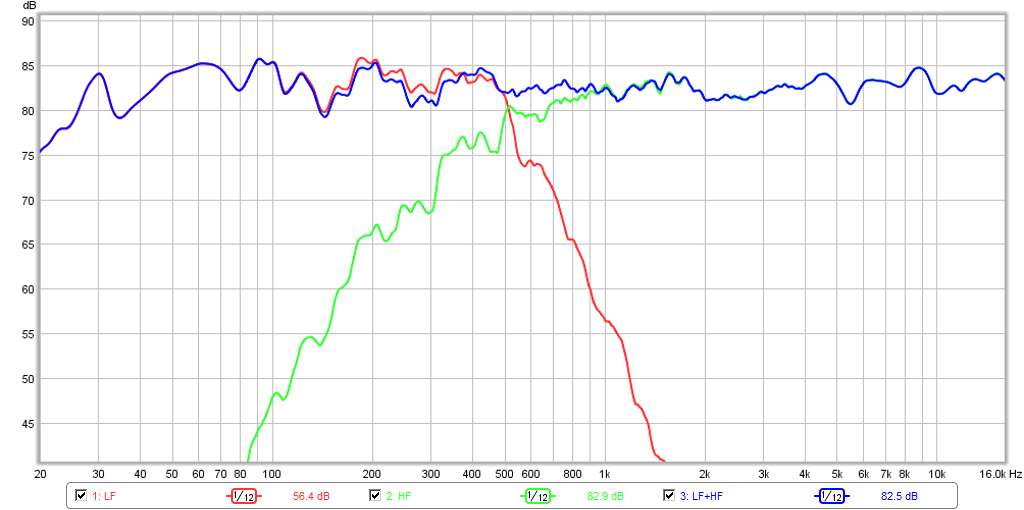
Measured Phase:
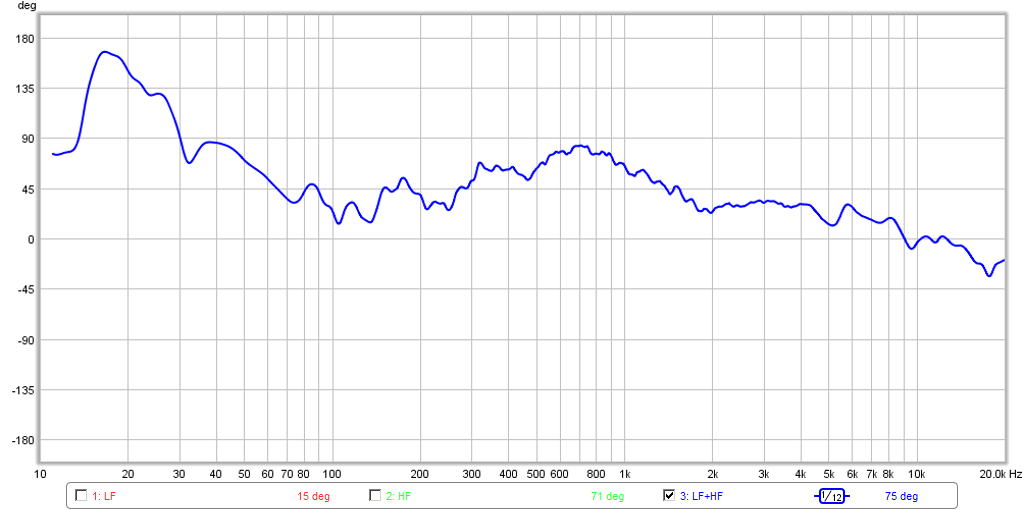
Measured Impulse Response:
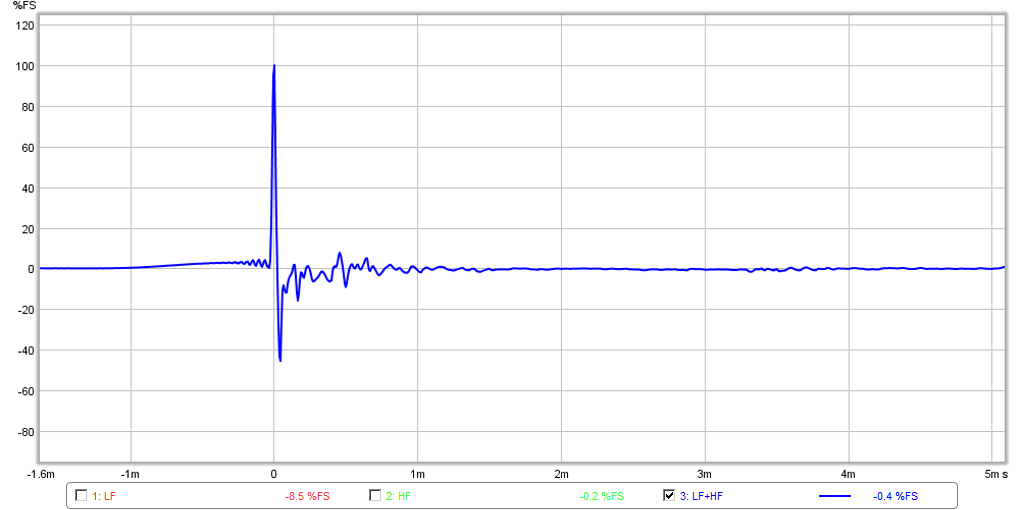
Measured Step Response - sort of works:
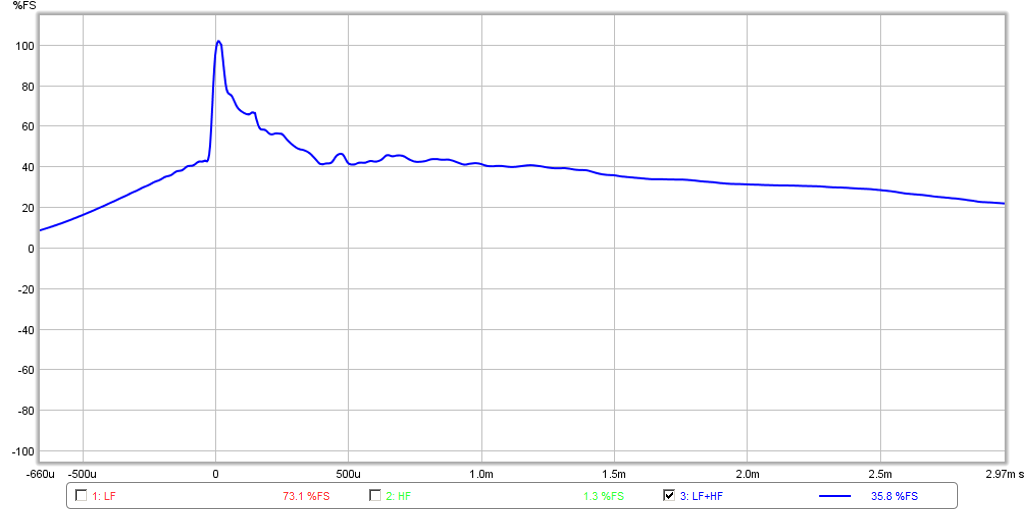
Measured Group Delay (1/3rd octave smoothing) - under 5ms at 50Hz, very similar to the simulation, and under 2ms at 100Hz, and not crazy through the XO region:
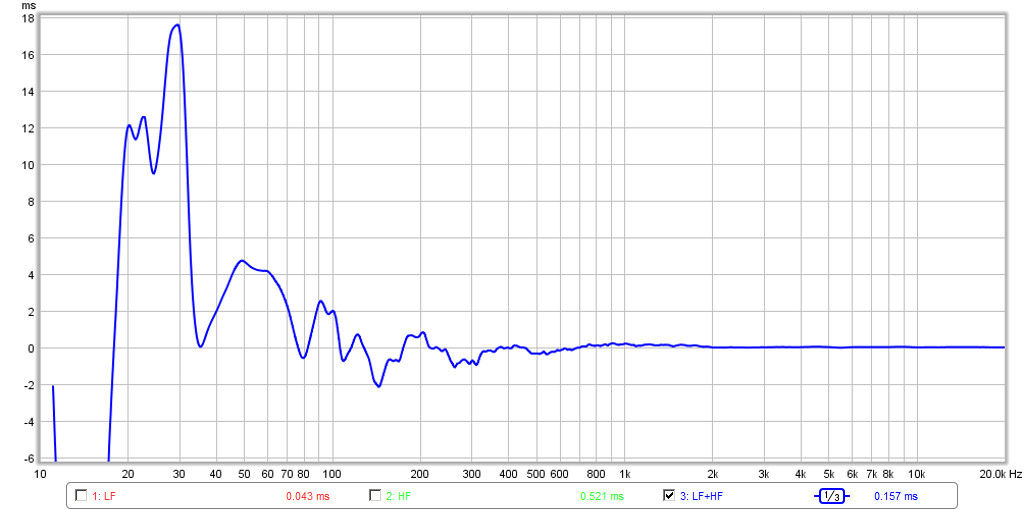
Measured distortion at moderate listening levels:
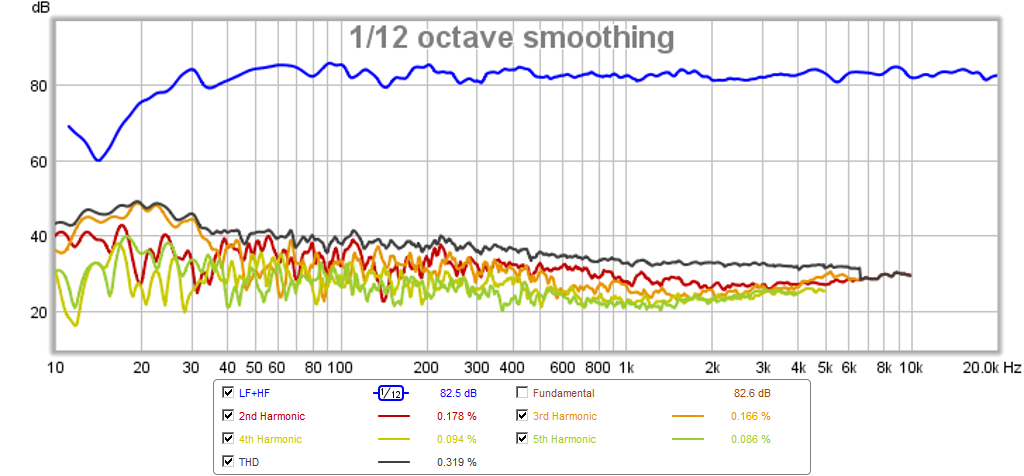
I really like the sound. Very natural and easy. The 4th order filter took care of any aluminum cone resonance I had before with a 2nd order filter. So it sounds very clean. The live sound signature of percussion is sort of there, the step response sort of takes a rise first from the woofer. I am listening more and will report back later. So far so good though.
After applying the settings in miniDSP exactly like what I posted earlier, the measured response was a little off since the acoustic centers of the drivers was not taken into account during the sim.
I got a new measurement mic (UMIK-1) and bought it calibrated by a third party, Cross Spectrum Labs. My old UMM-6 compares pretty well. I am only going to 16kHz because past 16kHz, the calibration on the UMIK-1 starts to get really steep and I don't want to it to increase the confidence of the measurement. Here is how the new Cross Spectrum Labs calibrated UMM-6 compares to the mew UMIK-1. They are within 2dB at the worst spots and otherwise fairly close.

So in summary:
- 4th order Butterworth at fc on woofer
- 2nd order Bessel at fc on mid/tweeter
- Set delay to 1/2 of 1/fc as start and adjust to account for acoustic centers - xo dip will fill in with correct delay
- Use some mild EQ to flatten response
Measured acoustic XO:

Measured Phase:

Measured Impulse Response:

Measured Step Response - sort of works:

Measured Group Delay (1/3rd octave smoothing) - under 5ms at 50Hz, very similar to the simulation, and under 2ms at 100Hz, and not crazy through the XO region:

Measured distortion at moderate listening levels:

I really like the sound. Very natural and easy. The 4th order filter took care of any aluminum cone resonance I had before with a 2nd order filter. So it sounds very clean. The live sound signature of percussion is sort of there, the step response sort of takes a rise first from the woofer. I am listening more and will report back later. So far so good though.
Attachments
-
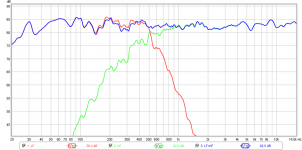 harsch-10f-rs225-xo.png62.7 KB · Views: 61,101
harsch-10f-rs225-xo.png62.7 KB · Views: 61,101 -
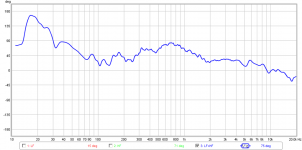 harsch-10f-rs225-phase.png41.8 KB · Views: 18,247
harsch-10f-rs225-phase.png41.8 KB · Views: 18,247 -
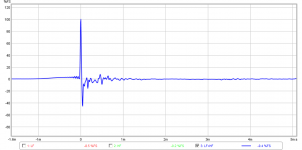 harsch-10f-rs225-ir.png29.9 KB · Views: 41,819
harsch-10f-rs225-ir.png29.9 KB · Views: 41,819 -
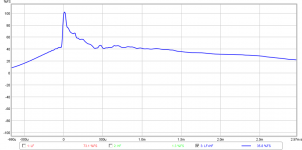 harsch-10f-rs225-sr.png30.2 KB · Views: 55,213
harsch-10f-rs225-sr.png30.2 KB · Views: 55,213 -
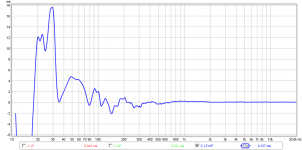 harsch-10f-rs225-gd.png49 KB · Views: 53,267
harsch-10f-rs225-gd.png49 KB · Views: 53,267 -
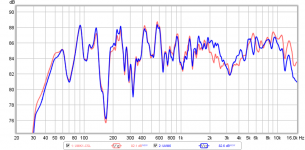 umm6-vs-umik-csl.png126.6 KB · Views: 2,357
umm6-vs-umik-csl.png126.6 KB · Views: 2,357 -
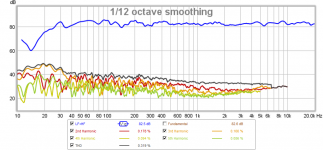 harsch-10f-rs225-hd.png139.8 KB · Views: 44,330
harsch-10f-rs225-hd.png139.8 KB · Views: 44,330
Last edited:
An acoustic 1st order XO is only possible if the drivers are flat for at least two octaves into the stop band. I have been able to do 2nd order with four parts. At least I get the 12dB roll-off for a while before the drivers start to roll off and the XO becomes 3rd order.
Bob
Bob
An acoustic 1st order XO is only possible if the drivers are flat for at least two octaves into the stop band. I have been able to do 2nd order with four parts. At least I get the 12dB roll-off for a while before the drivers start to roll off and the XO becomes 3rd order.
Bob
I think that is sort of what I am getting with the 10F, 2nd order (12dB/oct for an octave and a half, then 3rd order). The woofer low pass appears to be a clean solid 4th order all the way thru though.

The verdict is in: this is the BEST crossover so far on these 10F/RS225 Ref Monitors. I have been listening all day with all sorts of test tracks and different genres. What is clear is that the woofer is now well controlled in that there are no nasties higher up to muddy the 10F's beautiful voice. It sounds sweet and clear and open. Like the voice of an angel. But the RS225 backs up that clarity with well timed punch and precision for great dynamics which synchronize the sharp percussive sounds provided by the 10F in perfect handoff to the RS225. This is evident in the phase plot, the group delay plot, as well as how uniform the distortion is through the XO range.
Congratulation X sounds as you find a very good IRR XO solution that is within scope of miniDSP and just fill in the flaws previous pointed out by 5th element and satx for RS225-8 alu cone, based your subjective experience description must sound awesome, enjoy 😀.
Going these steeper slopes when needed and at same have it as a hardware based solution (with out a computer) to repair their XO phase distortions seems you gotta tell loud and clear to family a miniSharck is a wish under the Christmas tree, then the LR4/8 and that style as shown by Barleywater is no problem 😛.
For info your acoustic data in post 641 looks as very close to a electric DSP loop back of same filters data plotted in REW although it should be said my high pass was quick and dirty not a 100% Bessel slope.
Regarding slopes precision Bob Brines and xrk971 are you experiencing HD since you not talk about the posiibility that there almost seem to be one shelf-filter or two combined with a particular Q and frq point that can repair correct target slope hindered by drivers roll off down deep. Okay if XO is passive can be component hungry and expensive but when exercising a prototype with computer or hardware solutions from miniDSP should be at free cost but needs time put into find correct Q and frq.
Regarding UMIK-1 verse UMM-6 looks like IR at post 641 is with new UMIK-1 and show same scheme as mine those two same mics do. UMIK-1 seems speedier to take off from zero line and shaper to get back again from 100% than UMM-6, is that correct observed.
Going these steeper slopes when needed and at same have it as a hardware based solution (with out a computer) to repair their XO phase distortions seems you gotta tell loud and clear to family a miniSharck is a wish under the Christmas tree, then the LR4/8 and that style as shown by Barleywater is no problem 😛.
For info your acoustic data in post 641 looks as very close to a electric DSP loop back of same filters data plotted in REW although it should be said my high pass was quick and dirty not a 100% Bessel slope.
Regarding slopes precision Bob Brines and xrk971 are you experiencing HD since you not talk about the posiibility that there almost seem to be one shelf-filter or two combined with a particular Q and frq point that can repair correct target slope hindered by drivers roll off down deep. Okay if XO is passive can be component hungry and expensive but when exercising a prototype with computer or hardware solutions from miniDSP should be at free cost but needs time put into find correct Q and frq.
Regarding UMIK-1 verse UMM-6 looks like IR at post 641 is with new UMIK-1 and show same scheme as mine those two same mics do. UMIK-1 seems speedier to take off from zero line and shaper to get back again from 100% than UMM-6, is that correct observed.
Last edited:
Regarding UMIK-1 verse UMM-6 looks like IR at post 641 is with new UMIK-1 and show same scheme as mine those two same mics do. UMIK-1 seems speedier to take off from zero line and shaper to get back again from 100% than UMM-6, is that correct observed.
Byrtt,
Yes, the UMIK seems to have a faster slew rate and also less self noise and harmonic distortion. If you look at the HD plot, the usual "trees in a forest" spikes of HD at the bottom that I had with my UMM-6 measurements are not present. The speaker is actually cleaner sounding than I had previously measured. I am running into a sensitivity issue with UMIK though - it says in REW that max signal before clipping is 96dB. Is that a setup error and are you experiencing that as well?
The Harsch XO is exceedingly simple to implement and the quality of the xo is glass smooth. Somehow it just sounds better - no harshness and very very good. I have thrown every CD and test track in my arsenal at it and they all sound good. I will post clips later. This XO deserves its own thread on Multiway - it is a significant finding.
xrk971,
Thanks it sounds as a very welcome speaker system performance improvement that particular IIR XO type did add your particular build : )
I haven't noticed any sensitivity issues with UMIK-1, mayby in reality i haven't the skills to see the problem can you hint me what to look for to help. But noticed in Microsoft sound system when found new hardware that mixer input level set it self to a very low into level for that USB device UMIK-1 represent for windows, and in that REW tap on MS sound system not supporting ASIO or WASAPI that setting would mean be very important to be correct and don't know if you have touched that one or need to. One thing i noticed thru time is even one have 4 or 6 USB physical ports to connect to it is not bad to always connect to the same physical port if one would like windows to use and remember the settings personal set for samplerate/wordlenght/volume for the device.
Bought my UMIK-1 at a miniDSP dealer therefor my correction file is the original i can download by typing serial number at miniDSP website, now for yours I'm curious in you have it from a pro calibrating firm Cross Spectrum Labs, how do the original that belong to S/N compare to the pro one then, are they close or not.
Thanks it sounds as a very welcome speaker system performance improvement that particular IIR XO type did add your particular build : )
I haven't noticed any sensitivity issues with UMIK-1, mayby in reality i haven't the skills to see the problem can you hint me what to look for to help. But noticed in Microsoft sound system when found new hardware that mixer input level set it self to a very low into level for that USB device UMIK-1 represent for windows, and in that REW tap on MS sound system not supporting ASIO or WASAPI that setting would mean be very important to be correct and don't know if you have touched that one or need to. One thing i noticed thru time is even one have 4 or 6 USB physical ports to connect to it is not bad to always connect to the same physical port if one would like windows to use and remember the settings personal set for samplerate/wordlenght/volume for the device.
Bought my UMIK-1 at a miniDSP dealer therefor my correction file is the original i can download by typing serial number at miniDSP website, now for yours I'm curious in you have it from a pro calibrating firm Cross Spectrum Labs, how do the original that belong to S/N compare to the pro one then, are they close or not.
Last edited:
Byrtt,
So you are not hitting a 96dB ceiling on your mic? I must be doing something wrong. The CSL cal does not come with absolute cal - which is supplied by UMIK cal file. I use same port each time too and native Windows USB driver for mics. That is what miniDSP says to use as there are no drivers for the UMIK, just cal file. When I get chance I will show the miniDSP cal curve vs the CSL cal curve overlaid on same plot.
So you are not hitting a 96dB ceiling on your mic? I must be doing something wrong. The CSL cal does not come with absolute cal - which is supplied by UMIK cal file. I use same port each time too and native Windows USB driver for mics. That is what miniDSP says to use as there are no drivers for the UMIK, just cal file. When I get chance I will show the miniDSP cal curve vs the CSL cal curve overlaid on same plot.
xrk971,
No haven't hit a clipping level even I'm sure sometimes had run power amps more hot than needed under measurement.
That would be nice see a overlaid curve those two, it could be a hint what precision we get and if ones ambition application level needs it or factory level is fine.
Could it give meaning as TMM said over the worlds best mid thread, have a known reference baffle/driver measured and saved together with system settings, then you have a UMIK-1 saved measurement that could be used to check for drifted precision in future. And by that i mean when planet10 starts worry about what can be compared you then have some reference from when mic was brand new to check confidence.
No haven't hit a clipping level even I'm sure sometimes had run power amps more hot than needed under measurement.
That would be nice see a overlaid curve those two, it could be a hint what precision we get and if ones ambition application level needs it or factory level is fine.
Could it give meaning as TMM said over the worlds best mid thread, have a known reference baffle/driver measured and saved together with system settings, then you have a UMIK-1 saved measurement that could be used to check for drifted precision in future. And by that i mean when planet10 starts worry about what can be compared you then have some reference from when mic was brand new to check confidence.
Blind test of a transient perfect Harsch XO vs LR2
http://www.diyaudio.com/forums/multi-way/277691-s-harsch-xo-4.html#post4407112
http://www.diyaudio.com/forums/multi-way/277691-s-harsch-xo-4.html#post4407112
Greetings!
I am looking to build a FAST and was looking at the options I had.
I haven't used full range drivers before and based on the subjective and objective listening threads here, have settled on the TC9FD.
Xrk says it goes well in place of the Scan speak in his FAST, so as a stating point, I have chosen the TC9FD & RS225-8 combo.
I did also consider the Martin JK open baffle using the 15" Eminence woofers but my room is very small and not only will speakers that big overwhelm with their sound, I just do not have place the keep them.
Now, I am collecting parts to make a SE amp, with about 10-15 watts of output and I will be using this to run the full range. An class AB amp well be used to feed the woofers. That is a long term plan though and in the interim, I will be using tpa3116 amps to do the job.
So, while the TC9FD is going to be a gateway driver,I want get a better full range driver when my SE amp gets ready, as the recommended sensitivity is 90db plus.One plan is to parallel two TC9FDs. Apparently the Alpair 7.3 does well given it's sensitivity, so I guess the 10f should do as well. The Faitals look ugly IMO so they have been ruled out. That leaves me with choice of the Fostex fe126en.
I have seen the measurements of the fe126e on Troels' site and think they are ghastly but I guess there is no better choice. It is a different matter that the SE amp has distortion going through the roof with power past 5w.
But, the full ranger is not my problem. It is the RS225-8 used. I read the overall sensitivity of X's setup is 82dB? at 30?hz, because of baffle loss of the woofer.Or 88dB at 1khz in marketing speak.
If I do give in and get the fe126en, how will it go along with the RS225-8 given the difference in sensitivity?
Can't I simply run the full ranger at a lower volume given my small room, personal preference for low listening levels and make up the baffle loss with a little more boost on the woofer amp? This could be relatively easy on the mini DSP right?
Or, how about two TC9FDs and the RS225-8 in one cabinet?
The main reason for considering the Eminence 15A was the sensitivity. I really do like the RS225-8, because it is proven here and don't wish to go for another driver which will be more expensive or have some tradeoff and require me to put in some research and do my own measurements instead of simply ripping a existing design. Also, I don't have the equipment to measure nor the idea and budget to go about it, yet.
I am looking to build a FAST and was looking at the options I had.
I haven't used full range drivers before and based on the subjective and objective listening threads here, have settled on the TC9FD.
Xrk says it goes well in place of the Scan speak in his FAST, so as a stating point, I have chosen the TC9FD & RS225-8 combo.
I did also consider the Martin JK open baffle using the 15" Eminence woofers but my room is very small and not only will speakers that big overwhelm with their sound, I just do not have place the keep them.
Now, I am collecting parts to make a SE amp, with about 10-15 watts of output and I will be using this to run the full range. An class AB amp well be used to feed the woofers. That is a long term plan though and in the interim, I will be using tpa3116 amps to do the job.
So, while the TC9FD is going to be a gateway driver,I want get a better full range driver when my SE amp gets ready, as the recommended sensitivity is 90db plus.One plan is to parallel two TC9FDs. Apparently the Alpair 7.3 does well given it's sensitivity, so I guess the 10f should do as well. The Faitals look ugly IMO so they have been ruled out. That leaves me with choice of the Fostex fe126en.
I have seen the measurements of the fe126e on Troels' site and think they are ghastly but I guess there is no better choice. It is a different matter that the SE amp has distortion going through the roof with power past 5w.
But, the full ranger is not my problem. It is the RS225-8 used. I read the overall sensitivity of X's setup is 82dB? at 30?hz, because of baffle loss of the woofer.Or 88dB at 1khz in marketing speak.
If I do give in and get the fe126en, how will it go along with the RS225-8 given the difference in sensitivity?
Can't I simply run the full ranger at a lower volume given my small room, personal preference for low listening levels and make up the baffle loss with a little more boost on the woofer amp? This could be relatively easy on the mini DSP right?
Or, how about two TC9FDs and the RS225-8 in one cabinet?
The main reason for considering the Eminence 15A was the sensitivity. I really do like the RS225-8, because it is proven here and don't wish to go for another driver which will be more expensive or have some tradeoff and require me to put in some research and do my own measurements instead of simply ripping a existing design. Also, I don't have the equipment to measure nor the idea and budget to go about it, yet.
Surajspai,
Welcome to the world of FAST. For the RS225-8 as a woofer, you are rate limited by its sensitivity of 87-88dB and with baffle step loss, you are at 82dB as I have found (and predicted in the model). There is no point to having a higher sensitivity full range as you will just need to use pad it down (or drive with lower voltage) if active XO and bi-amping. You can shop around for a higher sensitivity pro audio woofer to get up to 96dB or so and then be at 90dB after baffle step loss. This will require at least a 12in woofer - not a compact box anymore. Alternatively, make it taller and put two R225's in parallel for 94dB and be back at 88dB overall, in which case a ScanSpeak 10F/8424 can work well. There are a couple of other 88dB to 91dB full range drivers out there.
Don't do dual TC9FD's as that will be too much sensitivity for a single RS225, and you get some frequency comb effects in the vertical.
Other good choices for the full range top include the PS95-8, Vifa TG9FD, Peerless P830986 or P830983 (2.0in), or Fountek FR88EX. Don't worry about sensitivity and get an amp that can drive at least 30 watts. I wiuld skip the SE tube business and go all class D (or AB if you want) - use the TPA3116D2 with the OSCON mods and bootstrap snubber mods and 19v laptop brick power supply for the full range and you will have plenty of power to go loud. If XO at 500hz, you can pump 60 watts into the TC9. The woofer cannot keep up with it though as that hits xmax at about 30 watts. So it is a near field monitor - not designed for loud party SPL or large spaces. If you want an excuse to buy the FE126en, this is not it - get it if you like it but my recommendation would be that it's not a state of the art driver, and has some ugly breakup peaks in the 7 to 8dB range that will give huge amounts of ringing in the response. if you want a great sounding fairly sensitive modern state of the art full range driver for the $60 price point, get the ScanSpeak 10F/8414 ($65). If you really crave 95dB sensitivity, I think you are better off with one of my favorites, the PRV 5MR450NDY ($100). Since you will use in FAST with XO > 300hz it works great there. Smoother than the FE126en.
SS 10F/8414
https://www.madisoundspeakerstore.c...canspeak-discovery-10f/8414g-10-4-full-range/
PRV 5MR450NDY:
http://www.parts-express.com/pedocs/specs/294-2705--prv-audio-5mr450-ndy-specifications.pdf
If you want loud, go with PA drivers - like this project of mine:
dual 12in pro woofers, dual 5in pro mids (actuaqlly same as 5MR450NDY full range), and a CD tweeter and waveguide all on OB. Sensitivity is about 100dB and max power handling of woofers and mids is in the 400 watt range.
http://www.diyaudio.com/forums/multi-way/277691-s-harsch-xo.html
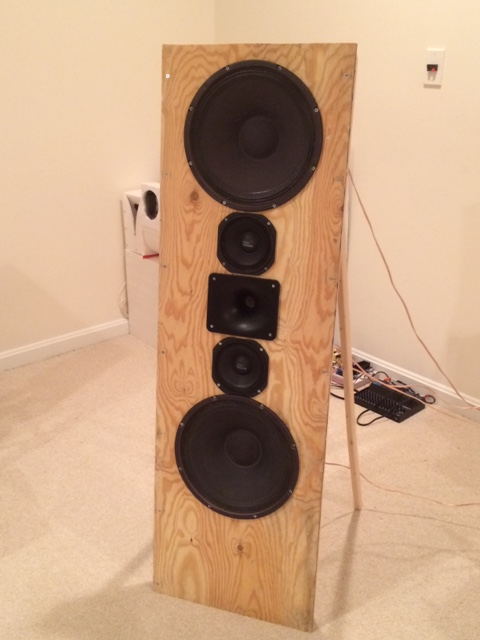
Welcome to the world of FAST. For the RS225-8 as a woofer, you are rate limited by its sensitivity of 87-88dB and with baffle step loss, you are at 82dB as I have found (and predicted in the model). There is no point to having a higher sensitivity full range as you will just need to use pad it down (or drive with lower voltage) if active XO and bi-amping. You can shop around for a higher sensitivity pro audio woofer to get up to 96dB or so and then be at 90dB after baffle step loss. This will require at least a 12in woofer - not a compact box anymore. Alternatively, make it taller and put two R225's in parallel for 94dB and be back at 88dB overall, in which case a ScanSpeak 10F/8424 can work well. There are a couple of other 88dB to 91dB full range drivers out there.
Don't do dual TC9FD's as that will be too much sensitivity for a single RS225, and you get some frequency comb effects in the vertical.
Other good choices for the full range top include the PS95-8, Vifa TG9FD, Peerless P830986 or P830983 (2.0in), or Fountek FR88EX. Don't worry about sensitivity and get an amp that can drive at least 30 watts. I wiuld skip the SE tube business and go all class D (or AB if you want) - use the TPA3116D2 with the OSCON mods and bootstrap snubber mods and 19v laptop brick power supply for the full range and you will have plenty of power to go loud. If XO at 500hz, you can pump 60 watts into the TC9. The woofer cannot keep up with it though as that hits xmax at about 30 watts. So it is a near field monitor - not designed for loud party SPL or large spaces. If you want an excuse to buy the FE126en, this is not it - get it if you like it but my recommendation would be that it's not a state of the art driver, and has some ugly breakup peaks in the 7 to 8dB range that will give huge amounts of ringing in the response. if you want a great sounding fairly sensitive modern state of the art full range driver for the $60 price point, get the ScanSpeak 10F/8414 ($65). If you really crave 95dB sensitivity, I think you are better off with one of my favorites, the PRV 5MR450NDY ($100). Since you will use in FAST with XO > 300hz it works great there. Smoother than the FE126en.
SS 10F/8414
https://www.madisoundspeakerstore.c...canspeak-discovery-10f/8414g-10-4-full-range/
PRV 5MR450NDY:
http://www.parts-express.com/pedocs/specs/294-2705--prv-audio-5mr450-ndy-specifications.pdf
If you want loud, go with PA drivers - like this project of mine:
dual 12in pro woofers, dual 5in pro mids (actuaqlly same as 5MR450NDY full range), and a CD tweeter and waveguide all on OB. Sensitivity is about 100dB and max power handling of woofers and mids is in the 400 watt range.
http://www.diyaudio.com/forums/multi-way/277691-s-harsch-xo.html

Last edited:
Does this nice 95 db 5" midrange sound as good as a little Vifa or ScanSpeak to your ears ? Is there a paper treatment 🙂 ?
Maybe in a futur test ? (I will try to give you this week 2 or 3 45 seconds made with audaticy to have your opinion, I'm looking also for a track with a triangle or cymballs (your track 2) in my Library but don't find something very usefull in a 45s test !)
Maybe in a futur test ? (I will try to give you this week 2 or 3 45 seconds made with audaticy to have your opinion, I'm looking also for a track with a triangle or cymballs (your track 2) in my Library but don't find something very usefull in a 45s test !)
I think the PRV 5MR450NDY is a unique world class full range driver. It only reaches 15kHz but cymbals, snare drums, etc sound excellent to my ears. Let me see if I can find a suitable sound clip for you. The driver has a few peaks near 9kHz but they are not bad. If you will be running them as tops in FAST with DSP they are easy to EQ out. The sheer headroom this driver has is stunning with 450 watts program power and 95dB sensitivity. At normal SPL's like 90dB to 100dB the distortion is exceedingly low. Voices have a unique transparency.
Here is my measured THD of the 5MR450 at 95dB: 0.06% THD!
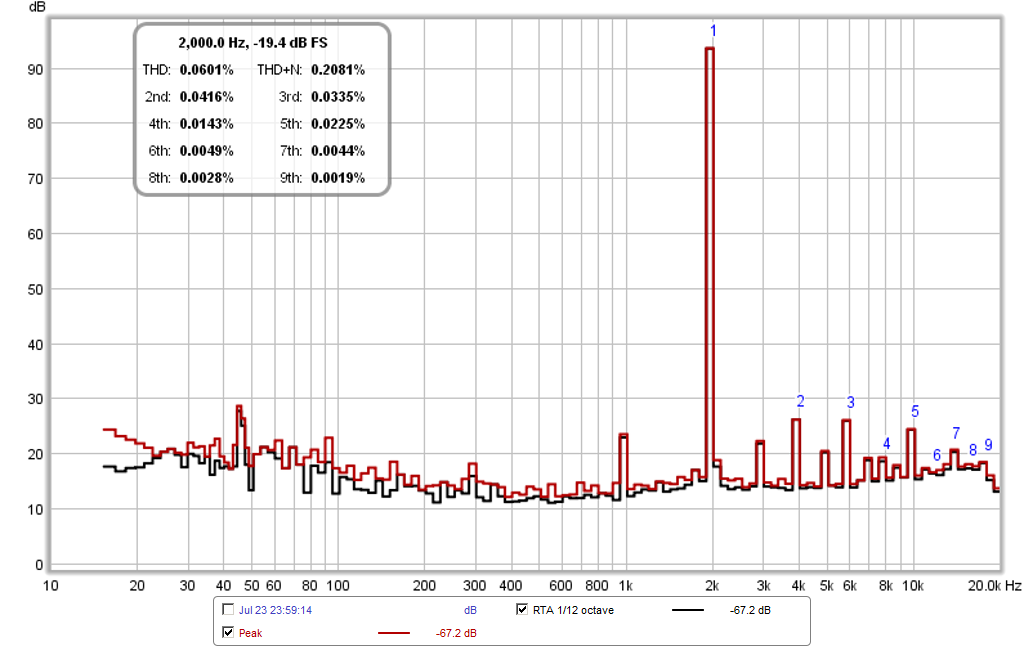
Sound clips are in the thread here:
http://www.diyaudio.com/forums/full-range/259293-prv-5mr450-ndy-fast-applications-3.html#post4003291

Sound clips are in the thread here:
http://www.diyaudio.com/forums/full-range/259293-prv-5mr450-ndy-fast-applications-3.html#post4003291
Last edited:
Thank you Xrk971...
Is it the good measurement ? fundamental is 2 K hz in this capture ? Bad subharmonic at 1Khz ? Cone break up ? Can't be heared with ears ?
Saw it performs well from 400 hz to 6Khz !
Is it the good measurement ? fundamental is 2 K hz in this capture ? Bad subharmonic at 1Khz ? Cone break up ? Can't be heared with ears ?
Saw it performs well from 400 hz to 6Khz !
Last edited:
It was good at 1kHz too (a bit higher at 0.177% THD with most of it as 2nd order at 0.163%). I am not sure why I only printed the RTA plot for 2k in the other thread. I dug through my data and found this - the SPL is closer to 100dB.
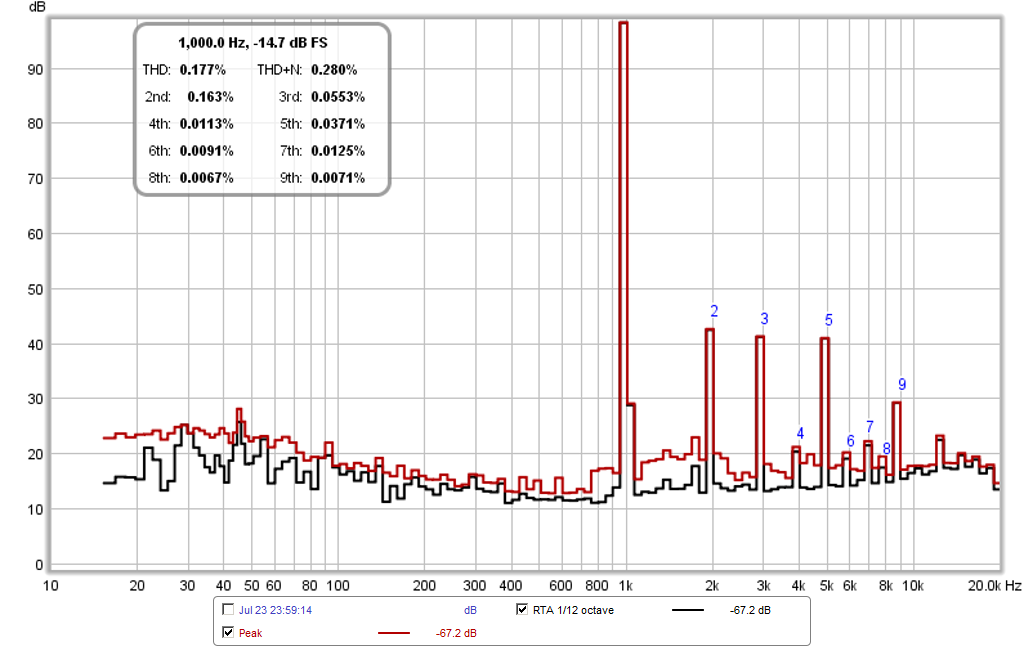
We should follow up in the proper thread as this driver is a bit OT.
Here is the correct thread to discuss this driver furhter:
http://www.diyaudio.com/forums/full-range/259293-prv-5mr450-ndy-fast-applications.html

We should follow up in the proper thread as this driver is a bit OT.
Here is the correct thread to discuss this driver furhter:
http://www.diyaudio.com/forums/full-range/259293-prv-5mr450-ndy-fast-applications.html
Attachments
Last edited:
Well, I do know that you are as likely to recommend the fe126 as you would do the chp70, so, no, I didn't come expecting to receiving any recommendations to buy it or any sort of justification.
I think of it as more like a last resort buy and surely there are better full range drivers to be discovered in addition to the already known good performers.
Also, I did see the measurements posted on Troels' site and they have poor resemblance to what the manufacturer supplies so that has definitely put me off of sinking money into them. I agree with the logic that something that sounds good ought to back claim up with measurements as to why it is preferred-an amp I built had a particular tweak applied to it.One person claimed that his version without the tweak sounded just as good while the other was adamant that it wouldn't perform optimally without that additional circuitry. Now, on measuring the two, the un tweaked version measured better with lesser distortion vindicating why it sounded good.
I also have all the parts required to mod the TPA boards, when they arrive.
Anyway, my main issue was, irrespective of the driver I used, how it would get along with a lesser sensitive RS225-8 and I have my answers.I guess greater output from the woofer amps should do it, or I can simply put some of my better amps into service. A search on Madisound tells me that there are small woofers which have better sensitivity but at nearly double the price of the 225-8s.
Else, I can go outright with 4x225-8s, though that will take away my budget for the mini DSP. Though it sounds like a good future upgrade plan.
On the topic of the mini DSP, will you share the exact settings used for the tc9fd-225-8 combo?
I guess in addition to the hardware, I need some plugins too? which all?
I think of it as more like a last resort buy and surely there are better full range drivers to be discovered in addition to the already known good performers.
Also, I did see the measurements posted on Troels' site and they have poor resemblance to what the manufacturer supplies so that has definitely put me off of sinking money into them. I agree with the logic that something that sounds good ought to back claim up with measurements as to why it is preferred-an amp I built had a particular tweak applied to it.One person claimed that his version without the tweak sounded just as good while the other was adamant that it wouldn't perform optimally without that additional circuitry. Now, on measuring the two, the un tweaked version measured better with lesser distortion vindicating why it sounded good.
I also have all the parts required to mod the TPA boards, when they arrive.
Anyway, my main issue was, irrespective of the driver I used, how it would get along with a lesser sensitive RS225-8 and I have my answers.I guess greater output from the woofer amps should do it, or I can simply put some of my better amps into service. A search on Madisound tells me that there are small woofers which have better sensitivity but at nearly double the price of the 225-8s.
Else, I can go outright with 4x225-8s, though that will take away my budget for the mini DSP. Though it sounds like a good future upgrade plan.
On the topic of the mini DSP, will you share the exact settings used for the tc9fd-225-8 combo?
I guess in addition to the hardware, I need some plugins too? which all?
Sure, no problem with sharing miniDSP settings. I use the advanced 2 way crossover plugin.
You can't just apply more power to RS225-8. It hits xmax at 30w - within reach of TPA3116.
You can't just apply more power to RS225-8. It hits xmax at 30w - within reach of TPA3116.
Hi!
So I ordered the drivers.I received the TC9FDs and am waiting for the RS225-8 to arrive.
I am collecting the rest of the stuff required little by little and had a few doubts.
1.You are using a laptop source, so do you take direct freed from the 3.5mm audio jack or do you use a DAC?
I was planning to get a decent DIY DAC bit that seems to be pointless if the DAC converts the signal to analog which is converted to digital and again back to analog by the DAC in the DSP.
2.More details on stuffing please. Any photos of how you have placed it? IIRC, you used fiberglass? Just lined the case walls with fibreglass or did you use additional poly fill to stuff?
3. The internal volume of the case works out to 25.2 litres or so. 24 litres is the design volume for the woofer so the dagger tl is just 1.2 litres?
4. I remember reading something on the lines of the volume of the dagger not being optimal for drivers other than the 10f. So what is the correct volume for the tc9fd? the total volume of the cabinet will change too I guess?
5. The dagger has to be completely sealed or can it be made venting to the rear as you suggested in another build thread? The chamber for the woofer has to remain sealed right?
6.Dagger tl is stuffed too?
So I ordered the drivers.I received the TC9FDs and am waiting for the RS225-8 to arrive.
I am collecting the rest of the stuff required little by little and had a few doubts.
1.You are using a laptop source, so do you take direct freed from the 3.5mm audio jack or do you use a DAC?
I was planning to get a decent DIY DAC bit that seems to be pointless if the DAC converts the signal to analog which is converted to digital and again back to analog by the DAC in the DSP.
2.More details on stuffing please. Any photos of how you have placed it? IIRC, you used fiberglass? Just lined the case walls with fibreglass or did you use additional poly fill to stuff?
3. The internal volume of the case works out to 25.2 litres or so. 24 litres is the design volume for the woofer so the dagger tl is just 1.2 litres?
4. I remember reading something on the lines of the volume of the dagger not being optimal for drivers other than the 10f. So what is the correct volume for the tc9fd? the total volume of the cabinet will change too I guess?
5. The dagger has to be completely sealed or can it be made venting to the rear as you suggested in another build thread? The chamber for the woofer has to remain sealed right?
6.Dagger tl is stuffed too?
- Home
- Loudspeakers
- Full Range
- 10F/8424 & RS225-8 FAST / WAW Ref Monitor
